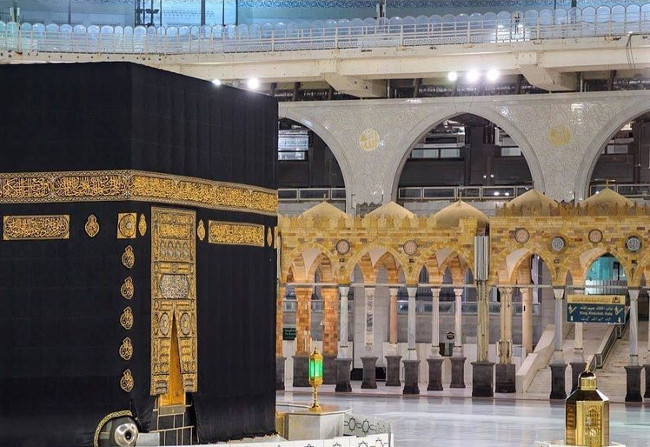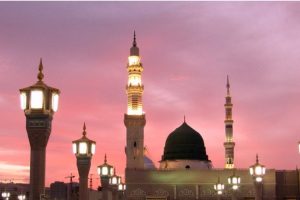
Five years prior to Rasulullah (sallallahu ‘alaihi wasallam) receiving nubuwwah, when he had reached the age of thirty-five, the Quraish decided to demolish the Ka’bah Shareef and reconstruct it.
The reason for the Quraish deciding to reconstruct the Ka’bah Shareef is that over the passage of time, the original structure, erected by Hazrat Nabi Ebrahim (‘alaihis salaam), had become old and weak. The original structure erected by Nabi Ebrahim (‘alaihis salaam) was roofless and the walls were not very tall, being just above the average height of a man, approximately nine hands in height. Over the passage of time, the structure had become old and was in need of reconstruction. Due to it lying on low ground, all the rainwater would flow into the structure and fill it. For this reason, the Quraish decided to rebuild the Ka’bah Shareef. (Al-Bidaayah wan-Nihaayah 2/367)
When all the leaders of the Quraish had unanimously agreed to demolish the Ka’bah Shareef and rebuild it, Abu Wahab bin Amr Makhzoomi, the brother of Hazrat Rasulullah’s (sallallahu ‘alaihi wasallam) paternal grandmother, addressed the Quraish saying:
“Bear in mind that the wealth spent in the reconstruction of the Ka’bah should only be from halaal earnings. The income derived from adultery, theft and usury should not be included, rather only halaal wealth should be utilized in its construction. Allah Ta‘ala is pure and He only accepts that which is pure. Hence, only use your pure wealth for His house.”
Distributing the Work Among the Various Clans
In order to avoid any person being deprived of participating in the noble task of reconstructing the Ka’bah Shareef, the work was distributed among the various clans. Accordingly, each portion of the Ka’bah Shareef was assigned to a different clan.
The portion near the door was assigned to the Banu Abd-e-Manaaf and the Banu Zuhrah clans. The area between the Hajr Aswad and Rukn Yamaani was allocated to the Banu Makhzoom and other clans of the Quraish. The rear portion of the Ka’bah Shareef was allocated to the Banu Jumah and the Banu Sahm, while the Hateem section was assigned to the Banu Abdud Daar bin Qusayy, Banu Asad and the Banu Adi clans.
At this time, the Quraish learnt of a merchant ship that had recently been wrecked in the port of Jeddah. On hearing of this, Waleed bin Mugheerah immediately set off for Jeddah and managed to obtain the timber of this ruined vessel for constructing the roof of the Ka’bah Shareef. A Roman builder by the name of Baaqoom had been aboard this ship. Waleed bin Mugheerah also brought him to Makkah Mukarramah to assist in the reconstruction.
Demolishing the Original Structure
After these initial stages of preparation (i.e. gathering the funds and materials and assigning the work to the various clans), when it was time to demolish the original structure, nobody had the courage to stand and break down the house of Allah Ta‘ala. Eventually, Waleed bin Mugheerah took a shovel, stood and proclaimed before Allah Ta‘ala:
اللهم لا نريد إلا الخير
O Allah! Our intentions are nothing but good (i.e. our intention in breaking the divine house is not evil)!
Saying this, he commenced demolishing the Ka’bah Shareef in the region of the Hajr Aswad and the Rukn Yamaani. The people of Makkah Mukarramah said, “Let us wait through the night to see that no punishment strikes Waleed. If any natural calamity or disaster befalls him, we will restore the house of Allah Ta‘ala to its former state. Otherwise, we will also assist Waleed in demolishing the present structure.”
The next morning, Waleed awoke safe and sound. He thus took a shovel and proceeded to the Haram. Observing this, the people understood that Allah Ta‘ala approved of their action (of reconstructing the Ka’bah Shareef), and thus everybody’s courage increased. Hence, they all gathered and worked together, with their hearts and souls, to accomplish this task. In this manner, they continued digging until the original foundation laid by Nabi Ebrahim (‘alaihis salaam) became visible.
When a man from the Quraish attempted to dig the foundation of Nabi Ebrahim (‘alaihis salaam), a loud explosion was heard in the city of Makkah Mukarramah, due to which they immediately discontinued digging further. They then commenced building the Ka’bah Shareef on the same original foundation of Nabi Ebrahim (‘alaihis salaam). Following the allocation that had been made previously, each clan individually gathered stones and began to build their section of the Ka’bah Shareef.
Rasulullah (sallallahu ‘alaihi wasallam) Being Selected for the Honour of Inserting the Hajr Aswad
Finally, when the reconstruction was complete and it was time to insert the Hajr Aswad (black stone) into its place, a great dispute arose. Swords were unsheathed and people were prepared to fight and kill one another to acquire the honour of raising the stone to its place.
After four or five days passed in this state with no decision being made, Abu Umayyah bin Mugheerah Makhzoomi, one of the eldest members of the Quraish, suggested that the decision be made by the first person to enter the doors of the Haram the next morning. Everybody agreed and all were pleased with this suggestion.
The following morning, when all the people reached the Haram, they saw that the first person to enter the Haram was none other than Muhammad, Hazrat Rasulullah (sallallahu ‘alaihi wasallam). The moment they caught sight of him, they spontaneously proclaimed with one voice:
هذا الأمين رضينا هذا محمد
This is the trustworthy one! We are pleased (for him to decide)! This is Muhammad!
Hazrat Rasulullah (sallallahu ‘alaihi wasallam) asked for a sheet, placed the Hajr Aswad (black stone) onto it and said, “The chief of each tribe should hold this sheet so that no tribe is deprived of this honour.”
They all approved of this decision and they all lifted the sheet. When they had all lifted the sheet to the place where the Hajr Aswad needed to be inserted, then Hazrat Rasulullah (sallallahu ‘alaihi wasallam) himself went forward, and with his blessed hands, raised the stone and inserted it into its place. (Rowdhul Unf 1/336-346 & Sharhuz Zurqaani 1/381-382)
In this way, Rasulullah (sallallahu ‘alaihi wasallam) ended their dispute in such a manner that he brought respect and honour to each clan, and Allah Ta‘ala blessed him with the greatest honour of placing the Hajr Aswad into the Ka’bah Shareef.
 Ihyaaud Deen An Effort to Revive Deen in Totality
Ihyaaud Deen An Effort to Revive Deen in Totality



